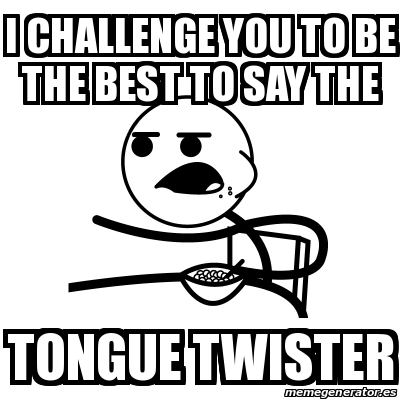Exposure Therapy
Doing what you hate to make it something you love
Welcome, aspiring polyglot! Avoidance is a trap that many language learners new and old fall into throughout the duration of their language acquisition. After all, it isn’t much fun to continuously work at things you are not good at doing. The unfortunate truth of the matter is that, in order to get better at anything, you have to do the thing. Pronunciation, verb tenses, vocabulary, deciding what to prioritize will usually come down to what you feel is your greatest weakness.
Tongue twisters
When I teach English, one of my favorite exercises is tongue twisters. Not because they aren’t enjoyable in other languages, but because as a native English speaker I often find myself getting tongue tied with vast variation of sounds we have to create to speak this language fluidly. It’s fun because I get to show the people with whom I work precisely how difficult it is for me as a native speaker to do the exact same exercise.
These work because they are directly focused on making your facial muscles bow to your will. Almost certainly the tongue twisters you find in English or in any other language are designed because they are difficult to say, not because they make any sort of sense or are things you might say in a day to day conversation. Think of them as HIIT cardio. High intensity, engaging many muscles, and done in intervals.
Over time working on your ability to say things that are difficult fluidly will make all manner of speech easier as well. That is when you can focus on your accent. After all, most of the time you spend doing this will directly affect your speech. Meaning, if you take the exercise seriously and ensure you are pronouncing everything correctly, your accent will improve naturally.
Native speakers
Of course, if you truly want to improve your accent you have to do a bit more than practice tying your tongue in knots. My best advice? Find a voice, or a few voices, that you really like listening to and which you would like to emulate. By that I mean, if you ever find yourself saying, “wow, I really like the way they speak”, then keep listening to them and try to mimic the way they say things.
Follow their pronunciation, their cadence, and their inflections. This is best done on YouTube or any podcast format where you can reverse by increments of 5 seconds. Having the freedom to go back whenever necessary to make sure you are copying the orator as close as possible is a must for this exercise. In fact, doing that is more important than actually understanding what is being said and what you are repeating.
That said, it is imperative that you branch out from time to time as well. Those who fall into the trap of always listening to the same people inevitably end up struggling to understand new people. Adding variety to your playlists and linguistic library is crucial if you want to avoid that fate; and you really do want to avoid that fate.
Explore multiple voices discussing multiple topics. Chances are if you can find something in English you can find something similar in your target language. There is no reason to step outside of your interests when learning a new language anymore. For all the negative consequences, the internet has given us access to the best resources in the world to learn any language we could possibly wish to speak.
Groups of people
After spending hundreds of hours learning to speak to a native speaker, or at least understand what they are saying, it is time to take on the final boss: groups. Speaking one on one is difficult, yes, but learning to speak in groups is a whole different level. Not only do you need to understand what everyone is saying, you need to be able to formulate your thoughts quickly enough to be able to add your two cents to the conversation.
Unfortunately, this means quite a bit of standing in silence and listening is in your future. If you’ve put in the work to really tune your ear then you are going to find that the amount of time requisite to adjust to group speech is far less than what is necessary to understand just one person at the beginning. For more on how to accelerate that process, be sure to check this article out:
Maybe speaking isn't the hardest part
Welcome, aspiring polyglot! Belief that speaking is the most difficult part of learning a new language is incorrect. There is a certain fear that comes with making mistakes while speaking, but that is different than overcoming an inability to understand what is being said. Since most people learn a language from one person, they believe they can underst…
Before you’re ready, start working to add to the conversations. Even if you are sitting alone at home watching a show or listening to a panel podcast, throw in your two cents to the conversation. Since there is no one to interrupt when you are studying on your own, there is really no excuse not to do this exercise. If you aren’t willing to look and sound foolish in front of yourself, you are going to have one hell of a time trying to converse with native speakers in the real world.
Conclusion
I understand the propensity to avoid the things that make one uncomfortable. Especially when an emotion as strong as fear, embarrassment, or shame is tied to the activity. The only way out, however, is through. This is especially true when talking about something like second language acquisition. When the stakes are this low, there is not really an acceptable reason to avoid any one aspect that makes you uncomfortable.
In fact, paradoxically, the more you avoid it the longer you will be forced to deal with it. Personally, I’d rather just take it head on, and I recommend you do the same. It will be difficult to overcome your greatest weaknesses, but you can do difficult things and be great. So get out there and tackle your biggest challenges and become great. I am rooting for you.
Requests
If you have anything you would like covered you can reach out to me on X, Instagram, or at odin@secondlanguagestrategies.com.
Additional Resources
Don’t want to spend time playing catch up? Pick up the 3 Months to Conversational book now available on Amazon! 3 Months to Conversational
For more long form content be sure to check out the website!
Subscribe for new content on YouTube and TikTok!
Learning Spanish? We have begun aggregating resources in you Spanish Resource Newsletter!
Don’t forget to pick up your very own French Language Logbook or Spanish Language Logbook!







